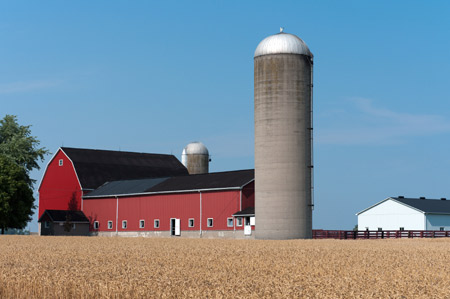 (The Wall Street Journal) – Harvests are under way of what are projected to be the largest corn and soybean crops in U.S. history, which soon will hit a global market already sitting on the largest-ever grain stockpiles.
(The Wall Street Journal) – Harvests are under way of what are projected to be the largest corn and soybean crops in U.S. history, which soon will hit a global market already sitting on the largest-ever grain stockpiles.
Indeed, some farmers are hoping for a weather hiccup somewhere in the world to curb yields and breathe life into crop prices that recently hit multiyear lows.
They may be waiting a long time.
It is a dramatic turnaround from four years ago, when prices for many commodities were soaring to the highest levels U.S. producers had seen in their lives. Back then, extreme drought slashed production of major row crops, forcing ranchers to cull cattle herds as feed costs soared.
But now farmers face a problem of the opposite sort. Prices for some crops are hovering near multiyear lows as storage facilities bulge with farm goods.
To make space for crops like corn after a massive wheat harvest last summer, Frank Riedl, general manager at Great Bend Co-op, a Kansas grain elevator and farm supplier, bought and leased extra land on which to build bunkers the size of football fields where he can heap millions of bushels of overflow grain.
“There’s an abundance of corn out here in the country and we don’t have the storage base for it,” he says. “Farmers are trying to find any place they can to dump their crops.”
The boom-bust cycle of commodity production in America has expanded across the globe in recent years, as crop and livestock farmers in South America, China and the Black Sea region have adopted farming practices that largely mirror those in the U.S. breadbasket. That has raised the potential risks and rewards for producers looking to sell, as weather, currency swings and policy changes in far-off countries have a greater impact on U.S. food prices than ever before.
“The world is still expanding production area, and because of that, this cycle could go on awhile,” says Dan Basse, president of Chicago-based commodities firm AgResource Co., who notes that farmers world-wide have added nearly 180 million acres to cultivation in the past decade, about as much as the combined acreage of the entire U.S. Grain Belt. Still, “it just takes one drought in a major production area to cure this,” he says.
Prices for cereal grains and meat globally declined in August and September from the year-earlier period, according to the United Nations’ Food and Agriculture Organization, due in part to large harvests across the Northern Hemisphere. The barnyard-wide glut stems from decisions made globally to plant more row-crop acres and to raise bigger herds in response to new demand and high prices during the most recent shortage.
“There’s an old industry adage that money makes milk, and more money makes more milk,” says Chuck Nicholson, a professor of supply chain and information systems at Pennsylvania State University, who focuses on agricultural markets. The current glut has “a lot to do with the decisions that farmers make in aggregate—producers can turn on the milk spigot relatively quickly and tend to be more reluctant to turn it off.”
Also fueling increasing production is a growing global population hungry for more protein in daily diets. Foods like infant formula, pork, cheese and poultry are becoming staples for a growing class of consumers who can afford meals that seemed luxurious to an earlier generation.
To make more protein, meat and dairy producers rely on a steady supply of inexpensive feed grains. The Food and Agriculture Organization projects that by 2050, the world would need to generate 455 million metric tons of meat a year to feed an addition 2.4 billion people. That is around 40% more than even this year’s massive production.
Along the way, however, producers are increasingly susceptible to missteps in the delicate dance of supply and demand across the world.
For farmers who raise animals for food, calculating when to expand the business is a gamble on market conditions that could be months or years away. It takes more than a year for a calf to mature to the point when it can be impregnated, and nine months to produce a new heir to be added to a milk or beef herd.
Some able to weather the lower prices say credit belongs to marketing arrangements, such as long-term contracts with buyers or farmers, locked in well in advance.
“We’re producing a very perishable product and have a few hours or at most a day to sell” the milk before it spoils, says Scott McGinty, president of Aurora Organic Dairy LLC, based in Boulder, Colo.
“You have to be close to your market,” Mr. McGinty says, “or the conditions that drove you into the business might be gone by the time you get there.”




